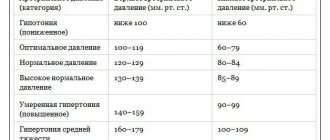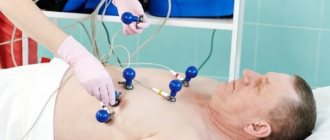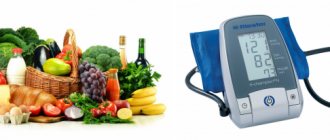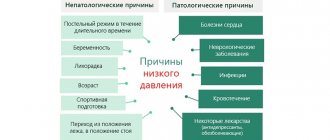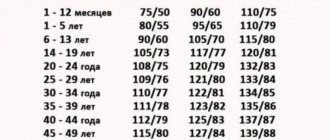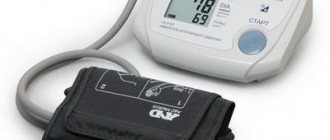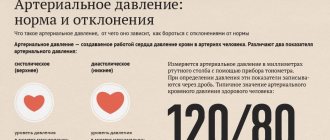Hypotension - features of the disease
Arterial hypotension (hypotension) – a decrease in blood pressure by 20% or more. Normally this figure is 120∕80 mm. rt. Art., then hypotension is diagnosed when systolic pressure drops to 90, and diastolic pressure drops to 60 mm. rt. Art. The disease can be congenital or acquired, develop as an independent disease or accompany other pathologies.
Causes of hypotension
In most patients, hypotension develops with a decrease in vascular tone. Normally, their walls should expand and contract due to the muscle layer, in response to an increase or decrease in fluid in the bloodstream. However, with some diseases, muscles become weak and unable to adapt to changes. A decrease in circulating blood is normally accompanied by a narrowing of the lumen of blood vessels so that it flows with sufficient force to organs and tissues. With hypotension, a decrease in blood and a slowdown in its movement lead to insufficient blood supply to the head and limbs, and then to other organs.
Hypotension often occurs in a chronic form. During its course, there is an alternation of periods of long-term remission and exacerbation. Seizures can be triggered by the following factors:
- chronic heart failure;
- neuroses, stress, insomnia, lack of rest during intense work;
- history of traumatic brain injury;
- a sharp decrease in the total amount of blood in the vessels (burns, injuries, blood loss);
- physiological hypotension when the body adapts to being high in the mountains, as well as in athletes with well-trained heart muscle and a large volume of circulating blood.
With low blood pressure, headaches are the result of insufficient blood supply to the cells and tissues of the brain. Weakness of the vascular walls and other factors lead to permanent or temporary ischemia. This is a dangerous disorder in which nerve tissue lacks oxygen and nutrients. The result is headaches and other characteristic symptoms. In addition, prolonged cerebral ischemia is the main predisposing factor to the development of stroke.
Symptoms of low blood pressure
Acute or chronic hypotension is a dangerous disease in which organs and tissues are subject to ischemia. Symptoms are associated with these processes and therefore pose a danger to the body. They can be triggered by stress; they also often appear in stuffy rooms and with a lack of oxygen. A typical complex may include the following manifestations:
- general weakness, lethargy, fatigue;
- nausea and dizziness;
- headache;
- pallor of the skin and mucous membranes.
If your blood pressure drops sharply and you have a headache, you may faint. This often occurs in poorly ventilated areas at high air temperatures. Symptoms quickly appear and increase, the patient experiences tinnitus, deterioration of hearing and vision. It is important to provide first aid in a timely manner in case of an acute attack of hypotension.
BP 90/60 with high and low pulse
Bradycardia (low pulse) with blood pressure readings of 90/60 can warn of a developing pre-infarction condition or VSD. Tachycardia (high pulse) indicates:
- loss of strength;
- anemia due to blood loss;
- vitamin deficiency;
- cardiogenic or hypovolemic shock;
- infectious and inflammatory processes;
- pregnancy.
The main pathology that provokes SBP/DBP – 90/60 is considered to be a disturbance in the functioning of the heart and blood vessels.
Headaches with low blood pressure
Headaches with low blood pressure can vary in nature and intensity. They can increase quickly if pressure readings decrease sharply, or accompany the patient constantly. The following features are characteristic of pain due to hypotension:
- lack of precise localization - discomfort spreads to the entire surface of the head;
- additional symptoms: nausea and dizziness;
- chronic course, with alternating periods of relief and exacerbation.
If your blood pressure is constantly low and your head hurts, this indicator must be maintained with medication. With prolonged use, migraine may develop. This is an acute headache that does not go away even after normalization of blood pressure and significantly affects performance.
Possible complications
It seems that blood pressure of 90 to 70 is practically safe for humans due to the body’s adaptive capabilities, but a minimal difference in values is fraught with complications. Moreover, if we talk about the treatment of hypotension and the prevention of negative consequences, then it is SBP/DBP of this level that is optimal for the possibility of radical correction of pathological conditions.
If pathological hypotension is not treated, then there is a likely risk of developing habitual but very traumatic fainting, ischemic stroke, dementia, loss of memory, cognitive skills, problems with vision and hearing. With long-term indicators, the development of encephalopathies, nephropathies, and cardiopathy is possible, resulting in serious complications.
Diagnosis of headaches due to hypotension
It is important to determine the exact reason why your blood pressure drops and your headache occurs. It is not difficult to measure this indicator, including at home. It is enough to use a tonometer and determine that the pressure has been reduced to 90/60 mm. rt. Art. and less. However, doctors at the Clinical Brain Institute recommend undergoing a full examination if hypotension occurs frequently and is accompanied by headaches. To determine the cause of this disease, additional techniques may be required:
- general and biochemical blood tests, as well as determination of the rate of blood clotting;
- Dopplerography - ultrasound of blood vessels with the addition of a contrast agent, informative for diagnosing blood flow in the neck and head;
- MRI of the cervical spine - allows you to determine osteochondrosis, intervertebral hernias and other pathologies that impair blood circulation;
- electrocardiography, ultrasound of the heart - prescribed for suspected heart failure and other diseases.
At the Clinical Brain Institute, you can undergo comprehensive diagnostics, which will help determine the cause of chronic hypotension. Our main advantages are the availability of precise and modern equipment, high qualifications and many years of experience of our specialists. After examination and diagnosis, the doctor will select a treatment regimen to relieve attacks of hypotension and reduce the manifestation of headaches.
What can you take at home?
At home you can do a number of simple actions without sudden movements:
- free yourself from clothes that constrain a person;
- wash with cool water;
- if desired, lie down with a cushion under your feet;
- take sedative drops: Corvalol, Motherwort, Valocordin;
- for headaches - Citramon;
- drink sweet tea.
Self-administration of medications will immediately raise SBP and DBP, which can lead to bleeding, intoxication, and shock. Therefore, if home help is ineffective, you need to call a doctor.
Treatment methods
If the patient has low blood pressure, a headache, weakness and dizziness, it is necessary to restore normal blood flow through the vessels as quickly as possible. Then it is important to consult a doctor to select medications for a course of treatment. The regimen is prescribed individually, depending on general health, blood pressure readings, accurate diagnosis and concomitant diseases.
First aid
If your blood pressure drops, your head hurts, or your health suddenly deteriorates, this indicates an insufficient supply of oxygen to the brain cells. It is important to restore your blood pressure before seeing a doctor. To do this, doctors recommend using several methods:
- take caffeine - this substance has a vasoconstrictor effect and is found in coffee and strong tea;
- provide access to oxygen, ventilate the room or go outside;
- take a sitting position and lower your head down - this normalizes blood flow to the brain;
- Unbutton the collar, loosen the cuffs on the sleeves.
After these manipulations, the pressure will return to normal, but the attack may recur. It is also important to notice its onset in time. If your health has sharply deteriorated, your head hurts, dark circles appear before your eyes, you must immediately inform others about the problem and ask for help.
Drug treatment
For the comprehensive treatment of headaches due to hypotension, a course of medications is prescribed. Some of them are designed to quickly narrow blood vessels and restore blood flow and are used to relieve attacks. The doctor will also recommend medications for a course of treatment. The regimen may include the following drugs:
- drugs that stimulate an increase in blood pressure, including those based on caffeine (Pyramein, Caffetamine);
- medications to improve blood supply to brain tissue and to prevent stroke (Glycine, Tanakan);
- herbal preparations for raising blood pressure and normalizing the functioning of the nervous system (tincture of Eleutherococcus).
The effectiveness of treatment must be constantly monitored by measuring blood pressure. To do this, it is enough to use a tonometer once every few days. Monitoring indicators too frequently leads to disruption of the nervous system and neuroses, which can provoke additional attacks of hypotension. Doctors at the Clinical Institute of the Brain will select a suitable treatment regimen, which will include only useful and necessary drugs, without unnecessary prescriptions and procedures. However, it is important to follow all instructions and take medications as scheduled.
Is 90 to 70 normal?
As follows from the protocols of the same World Health Organization, it is necessary to take into account the individual working standard, but it should not be below 100.
This is already an indication of pathological changes in the patient’s body. But this is not always the case. There are many physiological factors that can slightly reduce blood pressure levels. It also happens to smaller numbers.
Thus, when assessing normality, not only the tonometer indicators should be taken into account, but also the individual characteristics of the patient’s body and its physiology.
Prevention methods
Low blood pressure can be either congenital or acquired. In young people, hypotension is often caused by stress, poor diet, and vitamin deficiency (especially A, C and E). In order to maintain the health of the cardiovascular system and prevent most dangerous diseases, it is enough to follow a few simple advice from doctors:
- spend less time in stuffy rooms - this leads to oxygen starvation of cells and tissues;
- ensure proper rest - daily sleep of at least 7-8 hours is important for restoring the body after a working day;
- regularly engage in sports at an amateur level - the muscular layer of the vascular walls and myocardium also need constant training;
- eat well, get enough vitamins;
- Every morning, do a little exercise to improve blood circulation before getting up - this will help prepare the cardiovascular system for the start of the day and avoid sudden stress.
Often a headache with low blood pressure is a dangerous symptom. Doctors at the Clinical Institute of the Brain recommend not to self-medicate, since hypotension is often chronic and can progress. It is important to undergo an examination in time and select medications that will strengthen blood vessels, improve blood circulation, relieve headaches and prevent the dangerous consequences of the disease.
Natural causes
They account for up to 30-45% of all clinical cases (according to the European Society of Cardiology). They talk about things like this:
- Floor. Women are more susceptible to hypotension due to frequent hormonal changes, even outside of pregnancy. There is such a “wonderful” state as the menstrual cycle. Estrogens indirectly affect the regulation of vascular tone. In this case, it is easy to trace the cause-and-effect relationship: the next phase begins, hypotension appears. After 3-5 days everything goes away.
- Age. Decreased blood pressure is typical in young people. In older years, hypertension prevails, which is understandable. There may be exceptions to the rule.
- State of the endocrine system. There are peak hormonal moments: pregnancy, puberty, menopause. The latter is excluded immediately, since it causes hypotension in extremely rare cases. Puberty in adolescents 12-19 years old is associated with instability of blood pressure levels; if the level is always or predominantly low, this is an indication of a pathological nature.
Pregnancy is accompanied by a persistent decrease in blood pressure, this is normal. A diagnosis can only be made after the fact. If the condition has stabilized after 2-3 weeks from the moment of delivery, the reason is gestation, otherwise you need to look for a development factor. Sharp jumps in blood pressure are also uninformative: eclampsia is possible. This is the most difficult medical dilemma.
- Climate. In hot regions of the planet, people are less susceptible to cardiovascular diseases, since the blood pressure of “natives” is lower than average compared to residents of other latitudes.
This is not a pathology, but an adaptive mechanism. It also turns on for newly arrived people: a different intensity of solar radiation, atmospheric indicator, humidity, and air temperature are also affected. But, if the acclimatization process lasts more than 2 weeks, this is already a pathology. Just a change in region became a trigger factor.
- Features of professional activity. Workers in hazardous, hot industries are more susceptible to a stable decrease in blood pressure due to the same adaptive mechanism.
- General fitness of the body. Athletes have persistent hypotension; this is not a disease, but a feature of the body. At the same time, it is still accompanied by bradycardia. Later, such “hyperdevelopment” results in cardiac arrest and systemic problems. These people are advised to maintain a high level of physical activity throughout their lives.
The only criterion for distinguishing pathogenic conditions from physiological ones is the patients’ own feelings.
However, this point is erased with long-term hypotonic illness: the body is rebuilt in a new, abnormal way and the symptom complex is smoothed out.
The above is relevant only for the early stages of the process. Later, it is possible to identify and differentiate only through diagnostics.
Diagnosis and main symptoms
{banner_banstat4}
The diagnostic algorithm is simple:
- History taking, physical examination.
- UBC, OAM, blood testing for hormones.
- Tonometry, Holter.
- ECG, EchoCG, EEG.
- MRI.
- Load tests.
- Consultations of narrow specialists.
The list of manipulations can be expanded at the discretion of the doctor. The examination reveals the main symptoms of hypotension:
- weakness;
- headaches and chest pains;
- dyspnea;
- lethargy, apathy;
- digestive disorders;
- tachycardia.
An increase in symptoms with a sharp decrease in pressure indicators threatens a hypotensive crisis requiring emergency assistance.
